Monkey Tail Cactus Profile: Plant Info, Care & Propagation Guide Care
Written by Maggie
Dec 07 2021
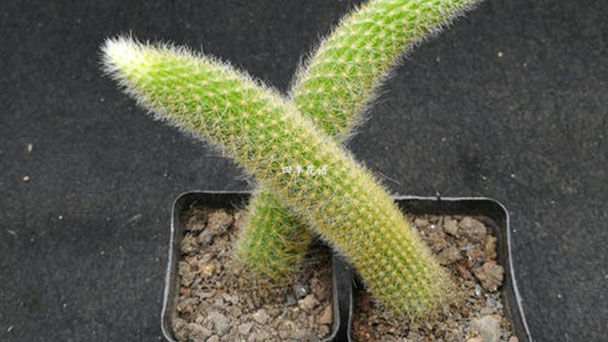
Monkey Tail Cactus (Hildewintera colademononis) is a long, pendulous succulent perennial plant of the genus Styla in the family Cactus. It is a peculiar plant type, and its slender white hair column is similar to the tail of a Monkey. It is an ideal pendulous pot plant. Keep your Monkey Tail Cactus plants indoors. Put them on balconies, windowsills and other places to beautify your home.
Monkey Tail Cactus Picture
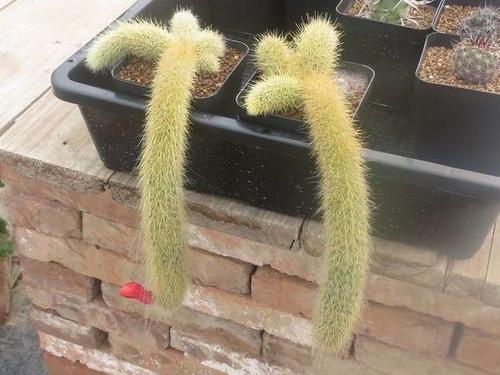
Monkey Tail Cactus Characteristics
The Monkey Tail Cactus is long. monkey tail cactus are small overhanging columns that are nearly 2cm in diameter and can be up to 1.5m long. Standard Monkey Tail Cactus adult plants are covered with long white hairs over 4 to 5cm in length, resembling Monkey Tail Cactus, and flower in summer and autumn. The flowers are 4 to 6cm long and 5cm in diameter, with red petals, deep red anthers, and light yellow stigma.
In the third year of the seedling, the main stem grows to an overhanging state of more than 20cm in length before it begins to grow long hair. Then the succulent plant enters the mature stage and begins to flower in the summer of the same year. After entering the mature stage to ensure that the plant gets sufficient light, the long white hair can continue to grow on the thorn base, until the whole overhanging stem segment.
Monkey Tail Cactus Habit
Monkey Tail Cactus (Hildewintera Colademononis) likes warm, wet and sunny environments. This succulent can withstand shade and drought, but it is not cold. Monkey Tail Cactus is also afraid of water. As for breeding soil, it is best to use acid soil with good drainage and ventilation.
Monkey Tail Cactus Propagation
Monkey Tail Cactus propagation includes seed seeding, grafting, and cuttings.
Grow Monkey Tail Cactus from Seed
Because the seedling needs to go through more than 2~3 years of seedling period to grow a representative long hair, it takes a long time, generally in mass propagation to select the seed propagation. The grafted Monkey Tail Cactus can accelerate the maturity stage and promote the growth of long hair, but it may also cause the excessive growth of hard thorns. Moreover, the existence of grafted rootstocks affects the original standard vertical pot plant shape, so the grafted Monkey's tail can be used for commercial rapid reproduction.
Monkey Tail Cactus Cutting Propagation
Monkey Tail Cactus Cuttings are a good method of reproduction in a normal home environment. Monkey Tail Cactus adventitious roots are active, and you can often see adventitious roots growing from the stem of the adult plant near the potted soil. As long as you cut off the hairy stem segments from the mother plant during the growing season, dry the wound and place them on dry culture soil, adventitious roots can be seen growing out in about 10 days. When the grafted Monkey's tail grows to a certain extent, it can also breed more plants through the above cutting method. (Find more Vine Plants Indoor here.)
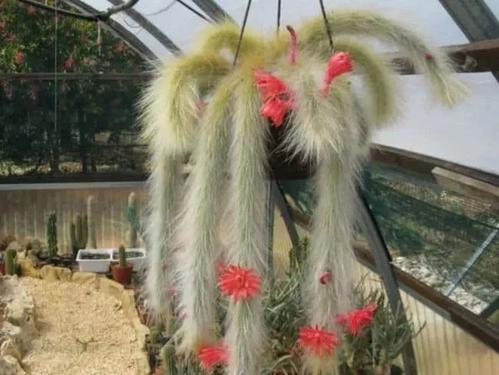
How to Care for Monkey Tail Cactus
Monkey Tail Cactus Soil Care
Monkey Tail Cactus (Hildewintera Colademononis) is a subject with cactus, are a cactus, its tolerance to drought, high temperature resistant ability is strong, selection of the best and the sandy soil is the ideal soil, sandy soil is more breathable, more suitable for ecological environment of maintenance, can use a 1:1 nutritional soil with sand mixed use.
Monkey Tail Cactus Lighting
Cactus family of Monkey Tail Cactus is also like the sun, especially in the southern region of the mouse tail palm growth will be better, more vigorous, summer high temperature weather do not need to worry, as long as the maintenance environment is not closed, can be ventilated, how high the temperature is not afraid.
Monkey Tail Cactus Watering
Water Monkey Tail Cactus does not need too much, just the right amount of water more flowering, like a normal water half a month once a week, half a month also do not have the too serious problems, will not affect the growth, but flowering water must not be broken, remember not to big tailwater rat tail palm.
Monkey Tail Cactus Fertilizer Care
In the spring of each year, a small amount of potassium dihydrogen phosphate fertilizer can be applied to the rat tail palm. The amount of fertilizer depends on the size of the pot and the number of trees to be maintained. Fertilizer can make the Monkey Tail Cactus grow thicker so that they don't look very thin.
Repotting Monkey Tail Cactus
Repotting of the Soft Monkey Tail cactus is best done once a year. This is because it grows vigorously and at a speedy rate. The re-potting is ideal after the growing and flowering season is complete. If the plant is fully matured, be sure to use a bigger pot with a new soil mix. The new soil mix must contain fertilizer and should be well aerated as new cuttings need a lot of nutrients to flourish. The growing and taking care of the Monkey Tail cactus has never been more natural than this. This unique-looking plant will most definitely give your front yard a sight to behold.
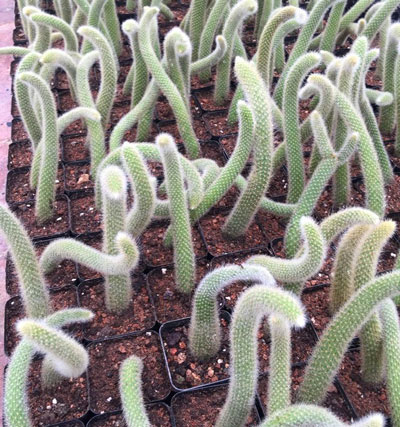
Monkey Tail Cactus Pests Care
This type of Monkey Tail Cactus (Hildewintera Colademononis) is particularly prone to pest infestation too. Spider mites, scales, and mealybugs are the common culprit pests. Most of these bugs are quite a nuisance but are quite easy to control. In the case of mealybugs, You spray your plant with a pressurized water hose to wash them off. A simple shower is guaranteed to spray the buggers away -check out our article on How to Get Rid of Mealybugs for further advisement. Another simple way to wade the bugs away is to rub alcohol; isopropyl, with a soft cotton swab. And rinsing off the alcohol with water before returning the plant to its spot.
As insects are by far the most annoying pests when it comes to Monkey Tail Cactus. This is because one is unable to notice their presence until they have damaged the plant to standard. Their control isn't as easy as the mealybugs and does require a keen eye. So one is inclined to monitor the plant carefully, and if you notice brown patches, then your plant is infected by these buggers. Proper watering and constant fogging by pumping up the humidity will chase these pests away.
Scales, on the other hand, do require hands-on control measures. These pests usually clamp upon the leaves' surface and hide under an impervious shell. Meaning, Spray away from them won't be as effective as desired. Therefore, one is advised to physically rub alcohol on the affected leaves and remove the scales. One should also pay keen attention to catch the infestation before it is too late. In the case of the Monkey Tail Cactus, the use of a soft toothbrush dipped in alcohol will be of great effect. Because if you use a cotton swab, most of it will remain stuck on the spikes.
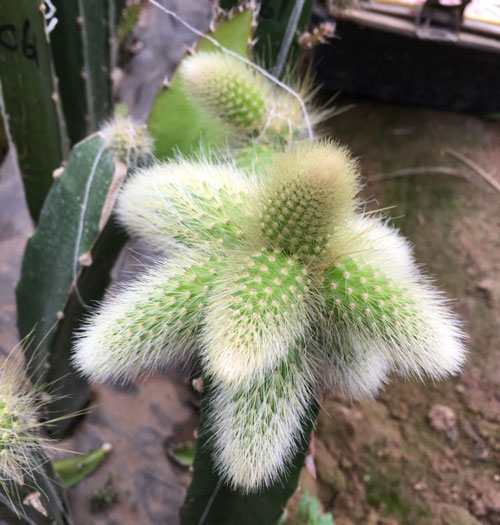
Read Next:
20 Popular Vine Plants Indoor To Grow
Latest Updated
- Benefits of Bugleweed - 7 Science-backed Health Benefits
- Bugleweed Dangers & Side Effects - Is It Poisonous?
- How to Plant Evergreen Trees - What You Should Know
- When to Plant Evergreens - Grow Guide for Evergreen Trees
- 12 Wonderful Evergreen Shrubs for Your Garden
- 12 Popular Evergreen Plants with Pictures for Beginners
- When And How To Prune A Lilac Bush Like a Pro
- How to Grow & Care for Lilac Vine (Hardenbergia Violacea)
- Japanese Lilac Tree (Syringa Reticulata) Care & Propagation Guide
- Shumard Oak Pros and Cons - What to Know
Popular Articles
- Winter maintenance of Antirrhinum Majus
- How to Grow Terminalia Mantaly Tree
- How to Grow and Care for Crossostephium Chinense
- How to grow Antirrhinum Majus in spring
- Peristeria Elata (Dove Orchid) Profile: Info & Care Guide
- Underwatered Snake Plant (Sansevieria Trifasciata) - Signs And How To Fix
- How to Care for Brazilian Jasmine Plant (Mandevilla Sanderi)
- How to Grow & Care for Graptopetalum Purple Delight in Summer
- Rosa Chinensis (China Rose): Plant Growing & Care Tips
- How to Care for Baby Sun Rose (Aptenia Cordifolia)